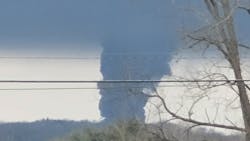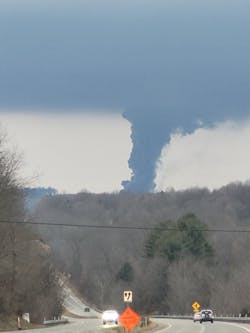Don’t get caught with your sensors down
It was in the days following the Norfolk Southern train derailment in East Palestine, Ohio, and the photo was taken from just across the state line in Darlington, Pa. It’s where my wife grew up and an area where many of my in-laws still live. All were safe and were spared evacuation orders but, figuratively, the fallout continues to hang over everyone’s heads.
The train derailment and subsequent threat of a chemical explosion serves as a not-so-subtle reminder of the need for industrial safety. (The photo depicts the controlled burn used to eliminate a more dangerous and uncontrolled explosion.) Safety is a task process control technology can play to fend off even more tragic accidents whether on the rails, along natural gas pipelines, or in a chemical processing plant and refineries, to name a few, if the technology works.
Recently, one of our regular columnists, John Rezabek, asked the question, “How old is too old?” I would also ask, when is safety at risk when controls are past their usefulness or faulty? Unfortunately, the U.S. railroad industry is faced with aging sensors and other equipment intended to prevent exactly the kind of accident that took place in a rural Ohio town.
In the case of the East Palestine accident, a well-publicized video shows a flaming rail car before the derailment. According to the National Transportation Safety Board, hot box sensors detected that a wheel bearing was heating up miles before it eventually failed and caused the train to derail. But the detectors didn't alert the crew until it was too late.
Before anyone thinks I’m blaming the technology, let me step back. As I pointed out earlier, process automation technology holds the key to safety, but only if investment in controls are ongoing. Throughout my time covering oil and gas and now additional processing industries, I wouldn’t have enough fingers and toes to count how many presentations I’ve watched about predictive maintenance technology and feedforward control – probably 50 times over.
The technology to alert operators to potential dangers is omnipresent. You need look no further than the pages of Control or this website for those available technologies. Just as we talk about the need for investment in energy transition and cybersecurity, there remains an even more pressing need for many companies in the processing industries, as well as manufacturing and transportation, to continually update their predictive maintenance and monitoring technology. I get it, costs are often an issue, especially for smaller operators, but the cost of not investing in maintenance and monitoring can outweigh those investment at any moment. It only takes one train derailment, one pipeline explosion, or one refinery fire, to open a company up to civil litigation and an industry to further scrutiny and ire from the public, government and media.
And, let’s be honest, the most important reason for investment in predictive maintenance is that no one wants to see homeowners or employees harmed.
The good news that there’s no reason for any of that to happen.
About the Author

Leaders relevant to this article:


